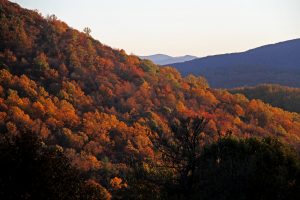Front Porch Blog
By Nolen Nychay
Editorial intern, Fall 2013

The Great Smoky Mountains National Park reopens today with state funding; meanwhile, hundreds of parks remain closed during shutdown. Photo courtesy of Wikimedia Commons
It is day 16 of the government shutdown, and while a resolution is being negotiated, budget cuts and furloughs at federal agencies continue to affect workers and communities near public lands.
Both the National Park Service and U.S. Forest Service have closed all offices outside of crucial emergency and monitoring services, according to agency websites. As a result, hundreds of national parks, many national forest facilities and 700 miles of the Appalachian Trail have closed.
Some undeveloped campgrounds, trails and recreation areas, however, remain open for public use within certain national forests. Because maintenance and volunteer cleanups are furloughed, the parks are encouraging users to pack out their waste and minimize their environmental impact. State donations to the National Parks Service have helped reopen a handful of national parks, including The Great Smoky Mountains National Park which set to reopen today thanks to donations from Tennessee and North Carolina.
The closures are expected to impact the many communities that depend on ecotourism. Nationwide, national parks and forests stand to lose approximately $450,000 per day in revenue, and bordering communities could lose as much as $30 million per day in tourist spending during the shutdown, according to the National Parks Conservation Association.

Appalachia’ public lands and facilities, such as the Blue Ridge Parkway and Pisgah National Forest, generate striking autumn views that attract seasonal tourists. Photo by Jamie Goodman
The timing is especially poor for national parks in the Blue Ridge Mountains, where colorful fall foliage attracted over 1.8 million tourists in October 2012 alone. Virginia’s Shenandoah National Park saw a record 250,000 visitors in October 2012 — these visitors contributed millions of dollars to nearby businesses, according to the park spokesperson Karen Beck-Herzog. During the partial government shutdown, 200 of Shenandoah’s 240 staff were furloughed.
The Forest Service notified 450 timber purchasers that timber sales are temporarily suspended during the shutdown as all logging operations on federal lands have stopped. Stewardship contracts, which contribute to forest and watershed restoration after clearcutting, have also been temporarily suspended according to the Forest Service. “This means another economic hit to rural areas in tough economic shape during the government shutdown,” Sen. Ron Wyden (D-OR) said to the Washington Post.
The U.S. Environmental Protection Agency is also affected by the the shutdown. With about 7 percent of its employees working, the EPA is facing an increased strain to meet deadlines for the Obama administration’s Climate Action Plan, emissions standards for nuclear power plants and national renewable fuel targets. The shutdown furloughs have also interfered with air and water pollution monitoring.
The U.S. Department of Agriculture oversees the Electric Loan program and the Rural Economic Development Loan and Grant program, but will not be able to make any loans or advances until the government reopens. Electric co-ops and other borrowers will be unable to improve services or pay short-term bridge loans, according to the USDA. Additional issues have arisen for agricultural communities that count on the Farm Service Agency, a USDA agency, since farmers will not be able to apply for federal loans during the shutdown.
The last government shutdown, in December 1995, lasted 21 days before “non-essential” federal programs and employees were reestablished.
PREVIOUS
NEXT
Related News

Leave a comment
Your email address will not be published. Required fields are marked *
